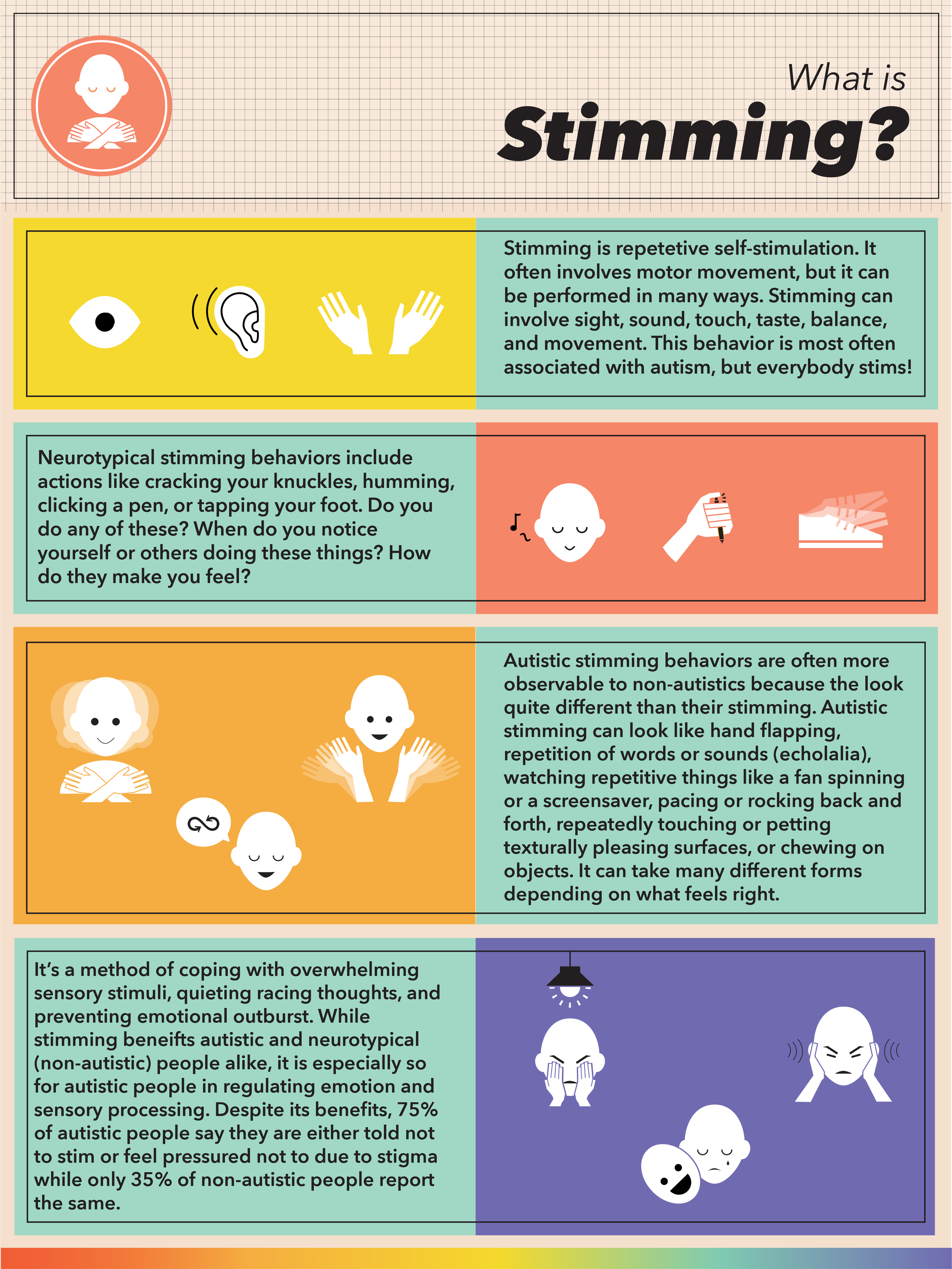
Addressing stigma through play
Stim Joy began as a graphic design MFA thesis, and investigates the stigma surrounding autistic stimming behavior, and how to make this behavior more socially acceptable.
Stimming is short for self-stimulatory behavior—meaning any action, most often repetitive, that provides the person initiating with some form of sensory stimulation. Stimming is most often associated with autism, but everyone stims; it just tends to look different along the spectrum of neurotypes. Non-autistic, or neurotypical stimming often looks like humming, tapping ones fingers or toes, drumming, and clicking pens. Neurodivergent stimming, and specifically autistic stimming, tends to be a bit more socially visible. It often looks like repeating words or phrases (known as echolalia), or hand flapping. Stimming is useful to both neurodivergent and neurotypical groups as a method of coping with overwhelming sensory stimuli, quieting thoughts, and preventing emotional outburst.
My approach for bridging this gap in understanding and social acceptance was to provide neurotypical individuals with an opportunity to stim in a manner that was not socially invisible to them not only to afford them an opportunity to become more aware of their stimming behaviors, but to also experience this stigmatized behavior in a fun and engaging manner. This is how I arrived at creating what I call “Stim Kits”, which are themed offerings of physical toys, AR experiences, and animated videos.
So, it should follow, if this is a behavior that is present across neurotypes that provides significant benefit, that all stimming should be viewed as part of ordinary human behavior, but this isn’t the case. 72% of autistic participants polled in a 2019 study said they have been told not to stim, and 75% of autistic participants in a 2021 study reported that did not stim in their preferred manner due to explicit and implicit messaging that the behavior is not socially acceptable. When you compare that to just 35% of neurotypical individuals reporting the same, there’s a clear social bias toward neurotypical behaviors.
Sources: 1. Kapp, S. K., Steward, R., Crane, L., Elliott, D., Elphick, C., Pellicano, E., & Russell, G. (2019). ‘People should be allowed to do what they like’: Autistic adults’ views and experiences of stimming. Autism, 23(7), 1782–1792. https://doi.org/10.1177/1362361319829628. 2. Charlton, R. A., Entecott, T., Belova, E., & Nwaordu, G. (2021). “It feels like holding back something you need to say”: Autistic and Non-Autistic Adults accounts of sensory experiences and stimming. Research in Autism Spectrum Disorders, 89, 101864. https://doi.org/10.1016/j.rasd.2021.101864
Brand Identity + Event Design
The original presentation of the research and design work that culminated from this research took the form of a design exhibition. Members of the public were welcomed to the Student Innovation Center located on the Iowa State University campus to learn about stimming and interact with physical and virtual stimming experiences. As the stim kits are visually distinct from one another, I developed a brand identity not only for the event’s promotional and educational materials, but also for the project as a whole.
The icons for Stim Joy center on visually depicting both the positive and negative experiences of autism, reasons autistic people may stim, and forms that stimming may take.
The designated typeface for Stim Joy is Avenir Next. This was chosen because sans-serif typefaces are more accessible and readable for neurodivergent audiences
Event + Promotion Materials
Event Poster
Facebook Event Page Banner
Event Entrance Sign
Neurodiversity symbol
The color scheme for Stim Joy is a muted rainbow that pays visual homage to the neurodiversity symbol. It is a popular symbol for autism and neurodiversity among self-advocates and preferred over the puzzle piece adopted by many autism groups.
Event Infographic









